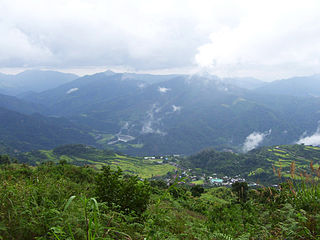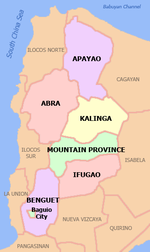Bontoc | |
|---|---|
| Municipality of Bontoc | |
 Bontoc in 2022 | |
 Map of Mountain Province with Bontoc highlighted | |
Location within the Philippines | |
| Coordinates: 17°05′24″N120°58′38″E / 17.09°N 120.9772°E | |
| Country | Philippines |
| Region | Cordillera Administrative Region |
| Province | Mountain Province |
| District | Lone district |
| Founded | 1908 |
| Barangays | 16 (see Barangays) |
| Government | |
| • Type | Sangguniang Bayan |
| • Mayor | Jerome B. Tudlong, Jr. |
| • Vice Mayor | Eusebio S. Kabluyen |
| • Representative | Maximo Y. Dalog Jr. |
| • Municipal Council | Members |
| • Electorate | 17,135 voters (2022) |
| Area | |
| • Total | 396.10 km2 (152.94 sq mi) |
| Elevation | 1,173 m (3,848 ft) |
| Highest elevation | 1,833 m (6,014 ft) |
| Lowest elevation | 804 m (2,638 ft) |
| Population (2020 census) [4] | |
| • Total | 24,104 |
| • Density | 61/km2 (160/sq mi) |
| • Households | 6,452 |
| Economy | |
| • Income class | 2nd municipal income class |
| • Poverty incidence | 4.49 |
| • Revenue | ₱ 193.7 million (2020) |
| • Assets | ₱ 380.3 million (2020) |
| • Expenditure | ₱ 147.8 million (2020) |
| • Liabilities | ₱ 159.8 million (2020) |
| Service provider | |
| • Electricity | Mountain Province Electric Cooperative (MOPRECO) |
| Time zone | UTC+8 (PST) |
| ZIP code | 2616 |
| PSGC | |
| IDD : area code | +63 (0)74 |
| Native languages | Balangao Bontoc Ilocano Tagalog |
| Website | lgubontoc |
Bontoc, officially the Municipality of Bontoc (Ilocano : Ili ti Bontoc; Tagalog : Bayan ng Bontoc), is a 2nd class municipality and capital of the province of Mountain Province, Philippines. According to the 2020 census, it has a population of 24,104 people. [4]
Contents
- History
- Geography
- Barangays
- Climate
- Demographics
- Economy
- Government
- Local government
- Elected officials
- Culture
- Education
- Secondary education
- Tertiary education
- Notable People
- References
- External links
Bontoc is 392 kilometres (244 mi) from Manila, 20 kilometres (12 mi) from Sagada, and 142 kilometres (88 mi) from Baguio.
Bontoc is the historical capital of the entire Cordillera region since the inception of governance in the Cordillera. The municipality celebrates the annual Lang-ay Festival. [6]
Bontoc is home to the Indigenous Bontoc people. The town also hosts the UNESCO tentatively-listed Alab petroglyphs.





























